Celebrating International Women’s Day
8 March 2023
Today (Wednesday 8 March) is International Women’s Day, an opportunity for us to celebrate the contributions made by women to science, forestry and to our organisation. At the same time, it creates space for valuable conversations about gender equality in the workplace and challenges both sectors to consider ways that women can be supported as they progress in their careers.
These conversations are particularly relevant as the forestry sector looks to capitalise on the opportunities mapped out in the Forestry and Wood Processing Industry Transformation Plan. Just as the ITP aims to diversify our production forests and exports to create new value through new low emissions products and energy sources, the sector must also consider how it develops a diverse workforce with people who are equipped with skills to grow the sector and build partnerships between government, Māori, businesses, and local communities.
Currently, 18 percent of people employed across the forestry sector in New Zealand are women. In a future where digital technology is likely to play a greater role in forestry to drive innovation, will there be more opportunities for women? If so, what would a gender action point for the ITP look like?
Future opportunities
The United Nations are celebrating this year’s International Women’s Day under the theme: DigitALL: Innovation and technology for gender equality.
Around the world, a persistent gender gap in digital access and STEM educational opportunities keeps women from unlocking technology’s full potential. At the same time, digital technology is opening new doors for the global empowerment of women, girls, and other marginalised groups.
When we consider the roadmap for transforming New Zealand’s Forestry and Wood Processing sectors, Scion portfolio leader for Data and Computational Sciences Claire Stewart says actions that lead to the industry adopting more digital technology for more precise decision-making and management is likely to impact the gender mix.
“Some of the mechanisation and automation of operations will mean more women will be attracted into the roles as it will not have as much physical/manual requirement.
“Power assisted hand tools are already being explored as well as tele operations, and this will all help solve the labour shortage issue.”
Today’s leaders
In 2023, more than one-third of Scion’s team of scientists are women. What’s more, women hold some of Scion’s most senior leadership roles: Tara Strand is GM for Forests and Landscapes and Justine Wilmoth is GM for Finance and Corporate Services. Scion’s Board of Directors is chaired by Dr Helen Anderson and other board members include Stana Pezic and Dr Melinda Webber.
In early February, Scion employed 66 women scientists, with many notable achievements, from winning awards to leading portfolios and research groups. Portfolio leaders include Yvette Dickinson (Silviculture and Forest Carbon), Heidi Dungey (Quantitative Genomics), Katerina Pihera-Ridge (Te Ao Māori – Research), and Claire Stewart (Data and Computational Sciences). Scion research group leaders include Kim McGrouther (Chemistry and Physics, Elizaveta Graevskaya (Data and Geospatial Intelligence), Marie Joo Le Guen (Materials, Engineering & Manufacturing, and Grace Villamor (Economy and Society).
Late last year, Dr Angelique Greene of Scion’s Biopolymers and Chemicals team received an Early Career Research Award at the Science NZ awards. Angelique received her PhD in chemistry in 2016 and is already leading several major research projects and making important contributions to others.
Also in 2022, a research team lead by Roya Rezanavaz was awarded $900,000 in Endeavour funds for the ‘Plant-inspired 3D-printed scaffold for tissue culture’ proposal.
Someone else we find inspiring is Scion senior technician Priscilla Lad. She led the development of the Flow Lab (in partnership with inFact) - a highly robust, low cost, wireless sensor network for the forest. The wireless datalogger collects real time and concurrent measurements of precipitation, throughfall, transpiration, diurnal tree growth, canopy evaporation, soil moisture and water potential, stream flow, groundwater, and stream water nitrate. This is part of the Forest Flows Programme and is world-first technology.
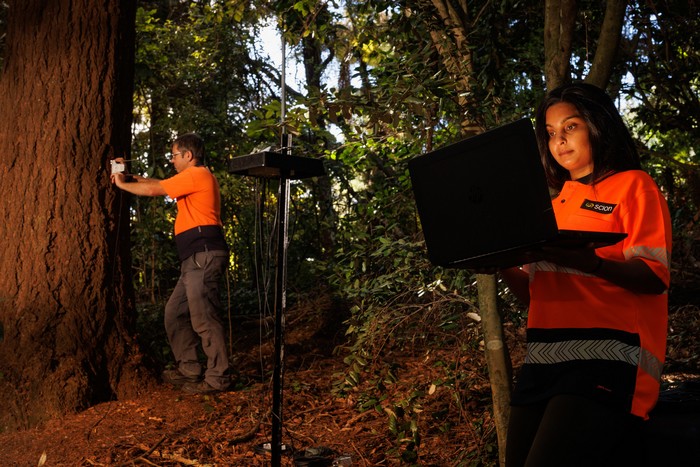
Last month Scion staff reflected on the significance of International Day of Women and Girls and Science. Commemorated on February 11 each year, the day seeks to recognise the achievements of women and girls in science while promoting gender equality and eliminating discrimination. The day inspires more women and girls to seek out STEM-related fields in science, technology, engineering, and mathematics.
Kim McGrouther says that while progress had been made for women pursuing careers in science, there is room for improvement. “There is still an inequity for women in science who also wish to raise families. It is critical that science organisations support mothers in science.
“With women in science fields, society gains a wider perspective on how science can impact our lives and environment.”
According to the latest UNESCO Science Report, women make up under a third of the workforce across science, technology, engineering, and maths, and even less in innovative fields.
A trip down memory lane
Mary Sutherland
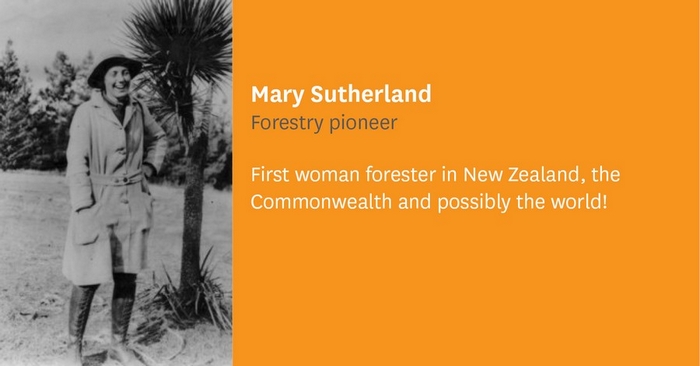
Mary graduated in 1916 from the University College of North Wales, Bangor. She travelled to New Zealand and was employed by the Forest Service where she worked from 1925. Her involvement with forest research in Rotorua is explored in this video.
A book about Mary’s extensive career, A Path Through the Trees, was written by Vivien Edwards. A celebratory launch was held at Scion in 2021.
Mavis Davidson
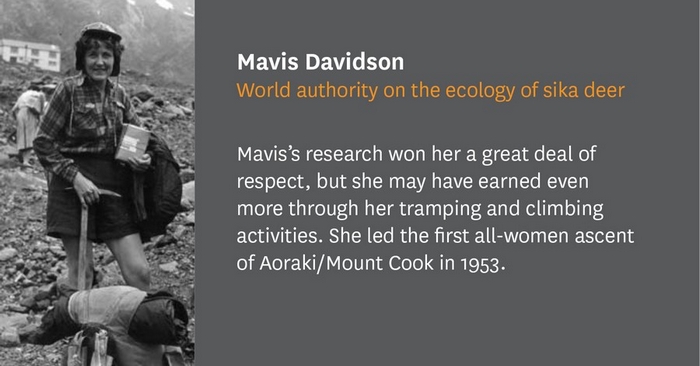
Mavis joined the Forest Service in 1958. She specialised in the study of sika deer, becoming a world authority in the ecology of the animals.
Ruth Gadgil
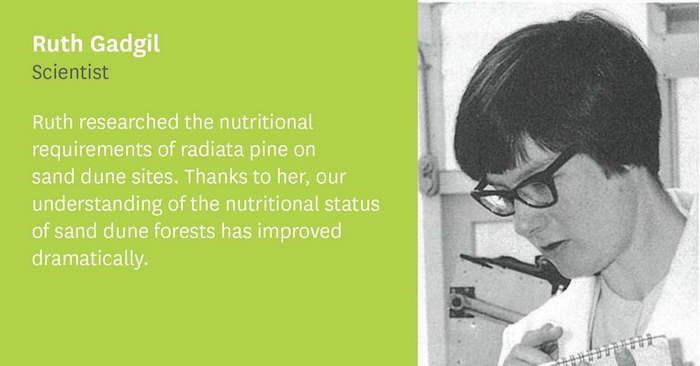
At the age of eight, Ruth Gadgil (then Ruth Weston) knew she wanted to be a naturalist. She gained honours in Botany at the University of Birmingham and a PhD in 1960 and started a career devoted to growing plants in difficult places.
Ruth started at Rotorua’s Forest Research Institute (FRI) in the nursery then quickly became involved in working on the nutritional requirements of radiata pine on sand dune sites.
Blanche Lois Kingdon
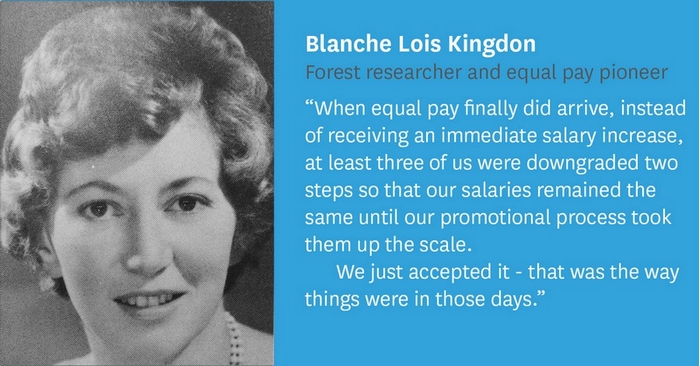
Blanche, known as Lois at Forest Research Institute (FRI), had a background in pharmacy. She was the first woman at FRI to be promoted to technical officer, but her greatest contribution was to the cause of equal pay for women.
Lois successfully applied for a Senior Technician role at Waipa and insisted on receiving the same salary as the previous (male) appointee. Her appointment had been announced but then it was cancelled by the State Services Commission, with an apology to the effect that they had not realised she was a woman. Never one to take things lying down, Lois sought support from the PSA and helped compile a submission that contributed to the “equal pay for equal work” legislation.
Support for women in forestry
In 1974, Heather McKenzie was the first woman to graduate from New Zealand’s School of Forestry - almost 60 years after Mary Sutherland arrived in the country.
Now, to encourage more women to look at forestry as a future career option and to provide support to those already employed or in training, the Wāhine in Forestry group was set up, with its first meeting held last year.
Formed by the Wood Councils, the group seeks to address the lack of a female perspective in the forestry sector and develop a professional network for women to participate in. A series of networking events have been planned for 2023 with a focus on providing people with role models, mentors and solutions to the unique challenges that face women by bringing women together and supporting each other.
Anyone wanting to learn more can visit www.wahineinforestry.co.nz, or email wahine@wahineinforestry.co.nz to receive newsletters or information about events.
